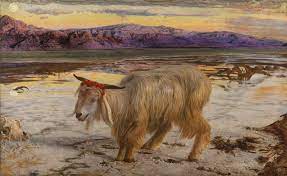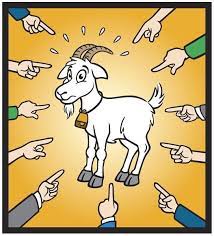
The Scapegoat, by William Holman Hunt, 1854

![]()
In the Bible, a scapegoat is one of a pair of kid goats that is released into the wilderness, taking with it all sins and impurities, while the other is sacrificed. The concept first appears in the Book of Leviticus, in which a goat is designated to be cast into the desert to carry away the sins of the community.
Then Aaron shall lay both his hands on the head of the live goat, and confess over it all the iniquities of the people of Israel, and all their transgressions, all their sins, putting them on the head of the goat, and sending it away into the wilderness by means of someone designated for the task. The goat shall bear on itself all their iniquities to a barren region; and the goat shall be set free in the wilderness. — Leviticus 16:21–22 NRSV.
The word "scapegoat" is an English translation of the Hebrew ,i> 'ăzāzêl Hebrew: עזאזל, which occurs in Leviticus 16:8:
....ונתן אהרן על שני השעירם גרלות גורל אחד ליהוה וגורל אחד לעזאזל And Aaron shall cast lots upon the two goats: one lot for the Lord, and the other lot for Azazel.
The Brown–Driver–Briggs Hebrew Lexicon gives la-azazel as a reduplicative intensive of the stem '-Z-L, "remove", hence la-'ăzāzêl, "for entire removal". This reading is supported by the Greek Old Testament translation as "the sender away (of sins)". The lexicographer Gesenius takes azazel to mean "averter", which he theorized was the name of a deity, to be appeased with the sacrifice of the goat.
Alternatively, broadly contemporary with the Septuagint, the pseudepigraphical Book of Enoch may preserve Azazel as the name of a fallen angel.
And Azazel taught men to make swords, and knives, and shields, and breastplates, and made known to them the metals of the earth and the art of working them, and bracelets, and ornaments, and the use of antimony, and the beautifying of the eyelids, and all kinds of costly stones, and all colouring tinctures.
Early English Christian Bible versions follow the translation of the Septuagint and Latin Vulgate, which interpret azazel as "the goat that departs" (Greek tragos apopompaios, "goat sent out", Latin caper emissarius, "emissary goat"). William Tyndale rendered the Latin as "(e) scape goat" in his 1530 Bible. This translation was followed by subsequent versions up through the King James Version of the Bible in 1611: "And Aaron shall cast lots upon the two goats; one lot for the Lord, and the other lot for the scapegoat." Several modern versions however either leave it as the proper noun Azazel, or footnote "for Azazel" as an alternative reading.
Jewish sources in the Talmud (Yoma 6:4,67b) give the etymology of azaze az, strong or rough, and el, mighty, that the goat was sent from the most rugged or strongest of mountains. From the Targums onwards the term azazel was also seen by some rabbinical commentators as the name of a Hebrew demon, angelic force, or pagan deity. The two readings are still disputed today.

Agnus-Dei: The Scapegoat (Agnus-Dei. Le bouc émissaire), by James Tissot
In Christianity, this process prefigures the sacrifice of Christ on the cross through which God has been propitiated and sins can be expiated. Jesus Christ is seen to have fulfilled all of the biblical "types"—the High Priest who officiates at the ceremony, the Lord's goat that deals with the pollution of sin and the scapegoat that removes the "burden of sin." Christians believe that sinners who admit their guilt and confess their sins, exercising faith and trust in the person and sacrifice of Jesus, are forgiven of their sins. Since the second goat was sent away to perish, the word "scapegoat" has developed to indicate a person who is blamed and punished for the actions of others. (Wikipedia)
![]()
From Ray Stedman:
"To adequately picture an event having many implications, such as the cross, required a multiplication of actions in the Old Testament which would not be necessary to duplicate in the reality. For instance, the Day of Atonement required two goats: one a scapegoat to be released into the wilderness, and the other to be slain and its blood sprinkled within the Most Holy Place. Both actions were needed to depict the death of Jesus as both bearing sin away forever and cleansing believers from its defilement. Similarly, the dying of Jesus fulfilled both the offering of a sacrifice and the presentation of its blood by the high priest." (Ray Stedman, IVP Commentary on Hebrews)
From Ray Stedman, The Need for Presentation
Notice the beautiful provisions that God has made, as taught in these pictures and types of Leviticus Chapter 16. Verses 1-2:
The LORD spoke to Moses, after the death of the two sons of Aaron, when they drew near before the LORD and died; and the LORD said to Moses, "Tell Aaron your brother not to come at all times into the holy place within the veil, before the mercy seat which is upon the ark, lest he die; for I will appear in the cloud upon the mercy seat." (Leviticus 16:1-2 RSV)
No greater privilege was ever given to Aaron the high priest than to be able to come before the very presence of God in the holy of holies as the shining presence of the Shekinah glory of God hung above the mercy seat. And yet God says, "Don't come at all times. Come only once a year." That limitation grew out of the fear aroused in the hearts of Aaron and the rest of the priests by the death of Aaron's two sons. You remember that in an earlier study we had the story of how they had brought "strange fire" before the Lord and thus were suddenly burned up by a flash of flame from the Shekinah glory of God. This had made Aaron and his other two sons afraid. Who wouldn't have been afraid?
I have often thought that these priests of old, when they realized that they were dealing with a God of righteousness and justice, had to be so careful that they did what he prescribed that they probably made up check lists like ones pilots use before they take off. I know I would have had up my sleeve a little card of certain items that I could check off to be sure that everything was right. And this feeling of fear imparted a sense of inhibition, of uncertainty, in coming before God's presence.
But even here, under the Law, with its shadows and its types, God gives a special provision by which the whole nation, in the person of the high priest, once a year at least, could come openly and boldly before the very presence of God himself, without any sense of fear. The priest could come once a year confidently into the holy of holies. This is a picture for us of what we are to do continuously in Christ, as you will see as we go further on in this story. Notice what the priest had to do. There are seven steps in the process. The first is found in Verses 3-4:
"But thus shall Aaron come into the holy place: with a young bull for a sin offering and a ram for a burnt offering. He shall put on the holy linen coat, and shall have the linen breeches on his body, be girded with the linen girdle, and wear the linen turban, these are the holy garments. He shall bathe his body in water, and then put them on." (Leviticus 16:3-4 RSV)
Step number one was to bathe himself and put on the linen garments. You remember that earlier in the book we had a listing of the garments the high priest wore. They were these inner garments made of linen, and then on top of them there was a great robe of beauty and glory with the bells around its hem, and over that the ephod, a sort of vest, and finally a breastplate. But all the outer garments were to be laid aside when the priest went in to the holy of holies.
Perhaps you have heard messages by preachers who have taught that when the high priest went into the holy of holies the people were able to tell whether he was still alive or not by listening for the tinkling of the bells on the hem of his robe. I have heard preachers describe with dramatic emphasis how the whole crowd waited with bated breath outside the tabernacle and listened to hear the bells, because they knew that the high priest would be struck dead if anything were wrong, if everything had not been confessed in the camp of Israel. Well, that is so much homiletical hogwash, because the high priest did not wear the robe with the bells into the holy of holies. He wore only the linen garments.
As we have already seen, those linen garments were a picture of the personal, private righteousness of the Lord Jesus, the inner righteousness which only God can see, not the public display of his sinlessness but that inner righteousness of his thoughts, his attitudes, his reactions. In all of the life of the Lord upon the earth there was not one moment when that inner righteousness was not perfect. Never once was there a yielding to the pressure upon him to give way to playing with filthy thoughts. He was normal, and he experienced every temptation such as we do, but never once did he give way. This is God's way of teaching us that as we come before his presence we are to come clothed with the inner righteousness of Jesus Christ, so that our inner life is as acceptable to God as our outer life. Both have been cleansed by the blood of his death on our behalf for our sins --the visible sins that we have committed, and the secret sins of the heart. The ground on which we stand is Jesus' righteousness, not ours. This is the first step. After this the priest was to offer the sacrifices, Verses 5-6:
"And he shall take from the congregation of the people of Israel two male goats for a sin offering, and one ram for a burnt offering. And Aaron shall offer the bull as a sin offering for himself, and shall make atonement for himself and for his house." (Leviticus 16:5-6 RSV)
Here is the provision made for the fact that Aaron was not, like Christ, without sin. He was merely a shadow, a picture of Christ, but was himself a sinful man like we are. And so he had to offer sacrifices for himself which, we are told in Hebrews 7, were not necessary for Christ. Jesus needed no sacrifice for himself. And then comes the requirement regarding the two goats, Verse 7:
"Then he shall take the two goats, and set them before the LORD at the door of the tent of meeting; and Aaron shall cast lots [almost like flipping a coin] upon the two goats, one lot for the LORD and the other for Azazel." (Leviticus 16:7-8 RSV)
Azazel is a name which many have been troubled and concerned about. Many scholars have debated its meaning, but the consensus seems to be that this is one of the names for Satan. So one goat was to be chosen for the LORD and the other for Satan. We will see why in a moment, Verses 9-10:
"And Aaron shall present the goat on which the lot fell for the LORD, and offer it as a sin offering; but the goat on which the lot fell for Azazel shall be presented alive before the LORD to make atonement over it, that it may be sent away into the wilderness to Azazel." (Leviticus 16:9-10 RSV)
It is important to note in passing that the goat was not named Azazel. The goat was not Satan. There are cults which teach that the goat represents Satan and that therefore Satan is the ultimate sin-bearer. But that is not true. The goat was sent to Satan, and the sins that were placed on it, as we shall see, were placed there to be sent to Satan.
But first we are concerned with the goat for the LORD. This goat marks the stake, if I may use that term, that God has in the crucifixion of Jesus. When we consider the death of Jesus we almost always think of it as on our own behalf. That is, we were forgiven there. His life was poured out on our behalf and, quite properly, from that event we count our forgiveness and acceptance before God. But what this is teaching us is that God also had a stake in the death of Jesus, that God was blessed and glorified and magnified in that death.
If your think about it you can see why. You see, forgiveness is not an easy thing for God to display. He can't do as many people seem to think he can -- simply look at our evil and say, "Oh, well, that's all right. Forget about it. I love you anyway. Just go on." If that were the way that we are forgiven then God would deny his character as a just God. But God is just and, in a sense, his justice struggles with his love. God's justice says, "Everyone who deliberately commits transgressions must be set aside from my presence. He cannot come before me." This book teaches that again and again. God's justice excludes us from his presence and sends us away. If God were just, and only just, he would wipe out the human race without exception. Not one of us could stand.
But God's love doesn't want to do that. Yet how can his love be expressed unless his justice is satisfied? That is what the death of Christ does. When God's Son hung on the cross God did not spare him a thing! He poured out upon him every bit of his wrath against sin. Every bit of his justice was satisfied in the death of his Son upon the cross. Thus God is vindicated. The whole world can now look at that event and say, "Yes, God is just -- even though he loves us." The death of Jesus freed God to show his love to us. Apart from his death you and I would never have known that he is a God of mercy, of compassion, and of tender, forgiving grace. We would never have seen that he is willing to suffer for us on our behalf, that he had that kind of heart. Thus God himself is magnified, his character is glorified before us, by the death of Jesus. And this is what is portrayed by the goat that was for the LORD. It was on his behalf that this goat was to be sacrificed. (Ray Stedman, The Need for Presentation.)

![]()

Email Lambert
Lambert Dolphin's Place (Home Page)
Lambert Dolphin's Original Web Site (1995)
Lambert's Personal Testimony
Newsletters by Lambert
Music for today
A Glorious Church
I Sing the Mighty Power of God
Jesus, The Light of the World
Pachelbel: Canon in D
Updated 2/25/2022